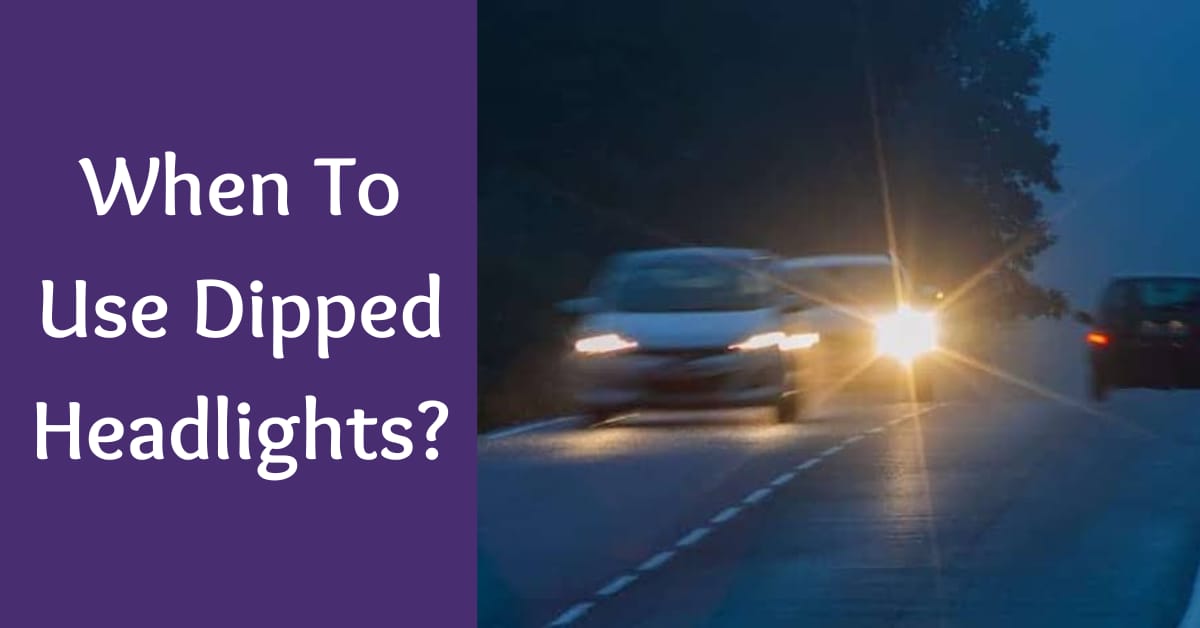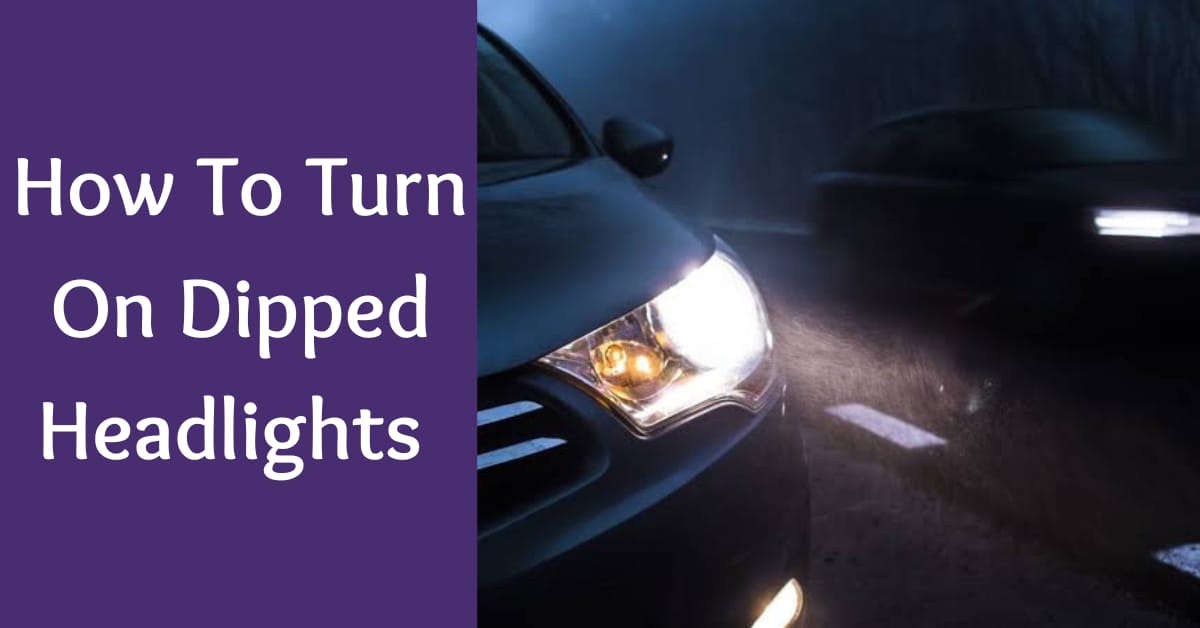Dipped headlights are the lower-power setting on the headlights. They are typically used when driving at night or in poor visibility. They provide a less powerful and less intense light than full headlights. It reduces glare for oncoming drivers. Dipped headlights are beneficial in reducing the risk of accidents. It makes it easier to see the road ahead.
When to Use Your Dipped Headlights To Stay safe on Road
Dipped headlights should be used when driving in fog or other inclement weather. It can be used in conditions. Such as at night, in tunnels, and when driving in an unfamiliar area.

Additionally, dipped headlights must be used in some countries when driving on highways and roads during the day.
1. In darker hours (in dusk or night):
The use of dipped headlights in darker hours is a recommended safety precaution. It is to increase visibility. Also to ensure the safety of drivers and pedestrians. It also helps other drivers to recognize your presence on the road.
Dipped headlights are designed to cast a low and wide beam of light onto the road. It should be used in combination with high beams.
2. In poor weather conditions:
In poor weather conditions, it is important to use dipped headlights. In order to ensure that other drivers can see you. Dipped headlights ensure that your vehicle is more prominent to other drivers in rain, fog and snow.
It also helps to reduce glare from other vehicles’ headlights. When using dipped headlights, be sure to turn them off when visibility improves. Or when you no longer need them.
3. When visibility is reduced:
When visibility is reduced, it is important to use dipped headlights to ensure. That other drivers are aware of your presence on the road. This is especially important in foggy or rainy conditions. Dipped headlights can help you to see the road ahead. Also it will alert other drivers that you are nearby.
4. Driving in the fog or rain:
When the fog is thick, you should turn your headlights down to their lowest setting. This will help to reduce glare and help you see more clearly. When driving in fog or rain, it is important to reduce your speed. This will help to reduce the chances of skidding or sliding on wet roads.
Dipped headlights are designed to provide a lower, wider beam of light. This helps you to see further ahead on the road. High beams can be dangerous in fog or rain. They can cause glare and reflection. When turning on your dipped headlights, make sure not to use your full beam setting.
In addition, when you’re driving through fog, rain or storm, must follow these 8 tips to drive safe.
5. Between sunset and sunrise:
Dipped headlights should be used between sunset and sunrise. It is to ensure maximum visibility and reduce the risk of accidents. Use of dipped headlights in these times is a legal requirement in many countries and states.
Difference Between Headlights and Dipped Lights
Headlights:
Headlights are used for illuminating the road and the environment around you. When driving at night or in poor visibility conditions. They are usually brighter than dipped lights. They are used to light up the entire area in front of the car. Headlights also help the driver to see potential hazards on the road ahead. Such as animals, potholes, and other vehicles. Mind that headlights are contrary to brights (high beams) due to their different functionalities.
Dipped Lights:
Dipped lights, on the other hand, are less bright than headlights. They are used to light up the area in front of the car at a reduced intensity. They are used to ensure that the driver can see the road. Also in the environment without blinding oncoming drivers. Dipped lights are usually used when driving at night.
How to Turn on Dipped Headlights?
The process for turning on dipped headlights varies depending on the vehicle. You can turn them on by rotating the headlight knob or switch to the dipped beam position. In some vehicles, you may need to turn the knob or switch to the “Auto” position.

It will automatically turn on dipped headlights when the sun sets. In other vehicles, you may need to press a button. Or flip a switch in order to turn on dipped headlights.
Dipped Headlights Law and Penalties
Headlight laws vary from state to state. But most states have laws in place requiring vehicles to use headlights. It is during certain times of the day and/or night.
The penalties for violating a headlight law can vary depending on the state. But usually involve a small fine and/or points on a driver’s license. In some states, a conviction for a headlight violation can also result. It can result in an increase in car insurance premiums.
Useful for You: Why do rally cars have tape on their headlights?
Benefits of using dipped beam headlights

1. Improved safety: By illuminating the road in front of the vehicle, dipped beam headlights improve the safety of drivers and passengers.
2. Reduced glare: As the beams are focused downwards, it reduces the amount of glare. That is experienced by other motorists. It makes it easier for them to see.
3. Reduced energy consumption: Dipped beam headlights use less energy than full-beam headlights. It makes them more economical and better for the environment.
Bulbs that fit the dipped beam headlights construction
Following are some bulbs that fit in dipped headlights. All are of high quality. They provide outstanding efficiency and results.
- Halogen bulbs, LED bulbs, and Xenon or HID bulbs.
They are all suitable for dipped beam headlights.
What color should my car’s dipped headlights be?
The color of your car’s dipped headlights will depend on your local laws. Most countries require dipped headlights to be white or yellow in color. It is important to check the local regulations before purchasing headlights for your car.
Do you know some cars have yellow lights? Yellow lights are getting popularity for their improved visibility and safety concerns. Yellow, doesn’t refer to ordinary lights with yellow color. Yellow lights are different headlight components serving specific purposes.
FAQs
when must a driver use dipped headlights?
In general, a driver must use dipped headlights when visibility is reduced due to low light conditions, fog, rain, snow, or driving in tunnels. They should also use dipped headlights when following other vehicles to prevent temporary blindness and potential accidents.
Do dipped headlights blind oncoming traffic?
No, dipped headlights are designed to reduce the amount of light. That is directed at oncoming drivers, and should not blind them.
What is the difference between dipped and full beam headlights?
Dipped headlights are low beam headlights. They are used for driving in built-up areas. They provide a low-intensity light that is directed downwards. So as not to dazzle other drivers.
Full beam headlights are high beam headlights. They are used for driving on open roads with no other vehicles. They provide a much higher intensity of light. They are directed further ahead so as to provide better visibility.
How Far Can You See With Dipped Headlights?
The visibility of dipped headlights is generally limited to around 100 meters. However, this can vary depending on the type of car. Also the road conditions, and the environment.
How to use your car lights to stay safe and legal?
1. Make sure you keep your headlights in good working order. Keep them on at all times, especially during times of poor visibility.
2. Use your headlights in the daytime when visibility is poor. Such as during rain, fog, or snow.
3. Make sure you always use your headlights when driving in tunnels or other dark places.
4. Use your fog lights when visibility is particularly poor. Such as in heavy rain or snow.
5. Make sure that you turn off your car lights when you are parked. Leaving them on is an offense in some countries.
6. Make sure that your headlights are properly aligned. And not dazzling other drivers.
7. Make sure you use your parking lights when you are parked in a dark area.
Is it possible to use dipped light as daytime running light (DRL)?
Yes, it is possible to use dipped light as a daytime running light (DRL). Dipped light is a type of low-beam headlight. It provides a more focused beam of light for driving on highways. This type of light is more energy-efficient. It can be used as a DRL. To help increase visibility during the day.
when do you have to switch on your dipped headlights?
A driver should switch between the full beam and dipped headlights. When approaching other vehicles, when approaching corners and when driving in built-up areas.
Can you use dipped headlights instead of fog lights?
Yes, you can use dipped headlights instead of fog lights. However, dipped headlights are not as effective as fog lights. When it comes to visibility in thick fog or snow.
Is there a limit on how bright dipped headlights can be?
Yes, there are regulations that limit the maximum intensity of headlight illumination. These regulations vary by country and state. So it is important to check the relevant local regulations for the specifics.
Conclusion
In conclusion, it is important to know when to use dipped headlights. It can help to ensure that you and other drivers on the road can remain safe. Dipped headlights should be used in the dark. And in low visibility conditions such as at night, in fog, or heavy rain. They help to reduce glare from oncoming headlights. As well as providing visibility for all drivers.
It is also important to switch your headlights back to full beam. When visibility improves and there are no other vehicles nearby. By using dipped headlights when appropriate, you can help to ensure. That everyone on the road stays safe.
